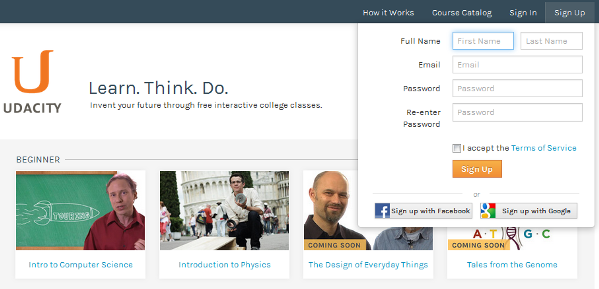 Udacity is a futuristic online higher education portal, which offers accessible, free and engaging classes that anyone can take regardless the time. Since the demand and expense of higher education is rising to new heights, it’s no more easily affordable for both students and society.
Udacity is a futuristic online higher education portal, which offers accessible, free and engaging classes that anyone can take regardless the time. Since the demand and expense of higher education is rising to new heights, it’s no more easily affordable for both students and society.
Udacity aims to make its students affluent in new age technologies, modern mathematics, science, and critical thinking. Those students will be trained to have skills with creativity & humanity to learn, think, and do. Udacity likes to call its students as Udacians.
[advt]According to Udacity, education is no longer a one-time event but a lifelong experience. Education should be less passive listening and more active doing and it should empower students to succeed not just in school but in life.
Udacity was born from a Stanford University experiment where founders Sebastian Thrun and Peter Norvig offered a course named “Introduction to Artificial Intelligence” online to everyone, for free. Over 160,000 students from more than 190 countries enrolled and thus, Udacity take birth.
“Our mission is to bring accessible, affordable, engaging, and highly effective higher education to the world. We believe that higher education is a basic human right, and we seek to empower our students to advance their education and careers,” the website says.

One can sign up to start using Udacity. Once signed up for a Udacity account, users can start taking classes straight away, for free. The user can track their progress and manage the courses in “My Courses”. Users can earn a certificate of completion once they finish the course.
Udacity has been made for High school students who are about to take some courses before joining colleges, college students who looks for an affordable alternative to high quality college courses and for professionals who looks to update their skills or shift careers by learning modern technologies and skills.
Udacity offers very much interactive, project-based exercises for study. Also they offer Bite sized videos for learning, the service of industry experts and passionate educators, virtual “field trips”, Forums and meetups with engaged peers to support learning and Certificates of completion.
For example, Udacity offers a free web development course, which covers an introduction to http and web applications, getting and processing user input, how to manage state, databases and persistent data, user authentication and access control, web applications as services using apis, scaling, caching, and optimizations to build a successful web application.
At present, Udacity offers around 30 courses in three categories, namely Beginners, Intermediate and Professionals. The Course Catalog can be viewed here.


Be the first to comment